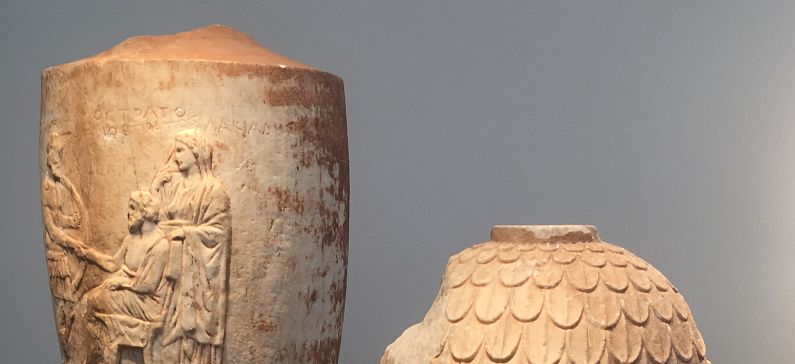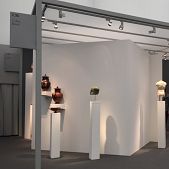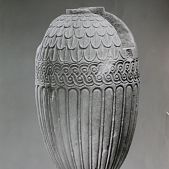
Greek archaeologist identified two ancient Greek vases on sale
Greek archaeologist Christos Tsirogiannis based in Cambridge is reported to have identified two ancient Greek vases on sale at the well-known Frieze Masters art fair in Regent’s Park, London. The two vases are of the lekythos type and according to The Guardian, they were placed on sale on behalf of the Swiss canton of Basel-Stadt. The canton proceeded with the sale in order to get back owed revenue resulting from the liquidation of assets belonging to its former resident Gianfranco Becchina who was convicted of illegal trafficking of antiquities.
In January 2015, the art squad of the Italian carabinieri hosted a press conference in Rome at which they proudly displayed more than 5,000 illicit antiquities, with an estimated value of €50m (£45m), that they had repatriated to Italy from a Switzerland-based Sicilian dealer named Gianfranco Becchina. He had been linked to widespread looting networks and his eventual conviction was deemed a victory in the battle against illegal trafficking of cultural property. The row over Becchina’s former stock has reignited after two vases that were once in his possession went on sale at the prestigious Frieze Masters art fair in Regent’s Park, London. They were on the stand of a Basel-based dealer named Jean-David Cahn – price “upon request”, but upwards of £100,000 apiece.
Nothing in accompanying documentation mentioned Becchina’s name, but Christos Tsirogiannis, a prominent Cambridge-based forensic archaeologist, identified the marble vases – known as lekythoi and dating from the 4th century BC – as related to the convicted dealer. Numerous objects from Becchina’s former dealings are believed to still be in the ancient art market, and identification usually results in their surrender and repatriation.
The Guardian has learned that the lekythoi were on sale in London on behalf of the Swiss canton of Basel-Stadt, which is seeking revenue it is owed after the liquidation of the assets of Becchina, a former resident. The canton says it received permission to sell the items from the carabinieri, who had sent back to Basel more than 1,000 pieces from the original seizure, stating they could not make a legal claim to ownership.
The Basel-Stadt public prosecutor admitted that it could not prove conclusively where the antiquities originated, nor that Becchina had ever legally owned them. But the Guardian has seen compelling evidence to suggest at least one of the vases was looted in Athens and trafficked to the disgraced dealer in the 1970s. The vases did not sell, but as yet the authorities in Basel-Stadt have no plans to return them to Greece, where they probably originated. The London-based Art Loss Register, which had cleared the sale of the objects, now says it may reconsider its position.
“The people involved in the transaction are all known to have previously been involved in other antiquities cases,” said Tsirogiannis, a lecturer at the Association for Research into Crimes against Art (Arca) and the American Center for Archaeology at Mycenae. “It’s the usual pattern that I have identified in trafficking of antiquities internationally several times during my career.”
The allegation will make uncomfortable reading for the organisers of Frieze Masters, an art fair dedicated to the exhibition and display of pre-2000 works of art that sits alongside its contemporary sibling Frieze London each year. Last year the Guardian’s Jonathan Jones described it as “a giant conceptual artwork” that “forces you to evaluate your attitude to obscene wealth”, adding: “It is a celebration of the market that mocks the idea that art means anything.”
The lekythoi were noticed and photographed at Frieze Masters by a former student at Arca, who forwarded the pictures to his former tutor Tsirogiannis. Over the past 11 years, Tsirogiannis has identified hundreds of illicit antiquities in museums, auction houses, private collections and galleries. He compares catalogue pictures with a cache of photographs and documents confiscated from Becchina and other disgraced dealers when their operations were halted during criminal investigations.
The dealers often photographed antiquities that passed through their hands, many freshly excavated, either in fragments or with soil encrustations still visible. The classified nature of the photographic archives, which can provide clear evidence of looting, is highly controversial. Tsirogiannis is one of few people outside a police department with access to them, but traders in ancient art insist they too should be able to see them to determine if stock they are offered is known to be illegal.
Tsirogiannis identified both lekythoi on sale in London in photographs in the Becchina archive. “It is the same lekythos without a doubt: the same shape with the same missing parts, the same marks of damage on the surface, the same scene in relief, and the same inscription, which is also transcribed by the middleman on one of the Polaroid images,” Tsirogiannis said.
In numerous previous cases, similar evidence has been used to identify illicit material and prompt ownership claims. Most recently, the Metropolitan Museum of Art in New York surrendered a 2,300-year-old vase that had spent decades on display in its Greco-Roman galleries after Tsirogiannis presented evidence it had been in the possession of Giacomo Medici, another convicted antiquities trafficker. All of Sotheby’s, Christie’s and Bonhams have withdrawn items from auctions after similar identifications.
However, the case of the lekythoi at Frieze is unusual in that the sellers did not publicly acknowledge the link to Becchina until they were challenged. Instead they insisted the items had been cleared for sale by the Italian authorities, who also have access to the confiscated archive of photographs.
Cahn, on whose stand the items were being offered, said he had been “very hesitant and very reluctant to handle this material” but was eventually reassured of its legality by the Swiss authorities. He added that he had been acting only as a broker for the canton, which took possession of the vases after Becchina’s arrest. Cahn forwarded documents to support the claim.
The Basel-Stadt public prosecutor’s office confirmed that after examining about 5,000 objects seized in the original raid on Becchina’s Swiss warehouses, the Italians had returned about 1,200 items, saying they had no claim to them. The objects were thereby offered for sale, despite the public prosecutor admitting: “Where they come from and the circumstances under which they were acquired, could not be determined conclusively.”
This assurance was sufficient for Frieze Masters to accept the items, and it referred the Guardian to the Art Loss Register, which similarly cleared the objects.
“If [the Italians] are not reclaiming it, it’s then in this grey area where legally it’s seemingly OK,” said James Ratcliffe, counsel for the Art Loss Register. “As far as [the Swiss] were concerned, they were selling with good title. Now if that’s not the case, and information has emerged that’s contrary to that, then quite clearly that’s something we would say changes our view.”
The carabinieri did not respond to requests for comment. It remains unclear whether they made a mistake in the case of the lekythoi, or whether they had identified the pieces in the confiscated photographs but judged that there was insufficient proof this was looted material.
The ministry of culture in Greece, where the antiquities were buried more than 2,000 years ago, have been alerted to the lekythoi’s presence by Interpol. The burden now rests on Greece to submit an ownership claim should it wish to do so.
For Tsirogiannis, the proven association with Becchina and the photographic evidence leave him in no doubt.
“The fact that these objects are being offered in such general terms, with incomplete collecting history, shows that they are absolutely tainted and therefore toxic for anyone who goes near them,” he said.
Read also:










